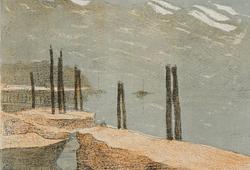J.E. Safra Collection – six Scandinavian masterpieces
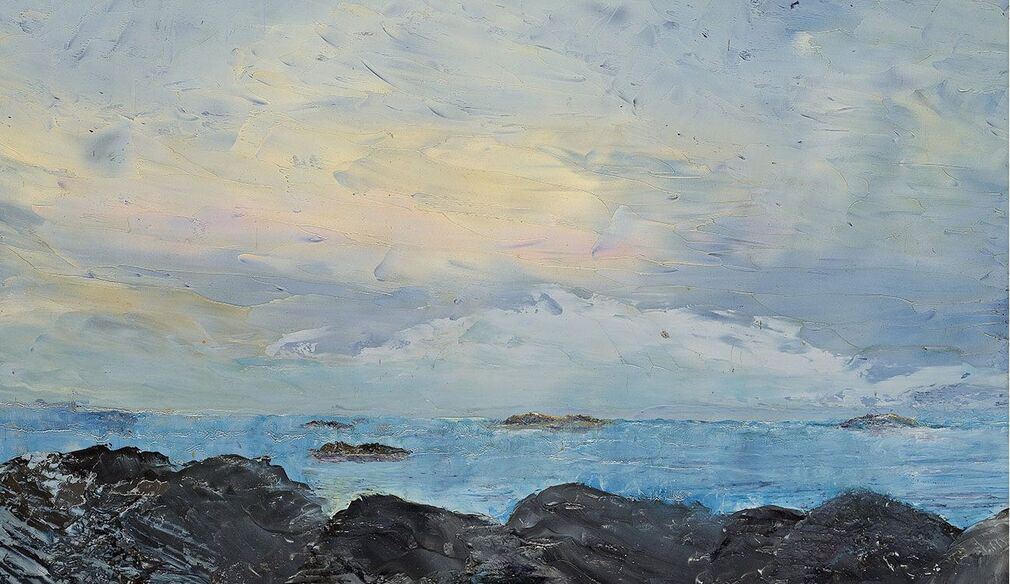
August Strindberg, In the Archipelago (verso Sea–Scape). Estimate: 8 000 000 – 10 000 000 SEK
J.E. Safra Collection at Important Winter Sale
Bukowskis is proud to, once again, have the honour to offer several masterpieces from J.E. Safra Collection.
Is the love of Art genetic or is it acquired? Does it demand extensive study, or is emotional response sufficient? Certainly, my father possessed a spirit for fineness in all things, a propensity for Beauty. And so it may be partly the inheritance of sensibility inspired by parents – a natural inclination to theme, technique, the visual and spiritual evocation of a fine art. My collecting grew in time and, yes, study through observation, reading the lives of the Old Masters, integrating the knowledge of experts. But most importantly perhaps it is the dialogue that comes through a great painting that invokes the eye and speaks to the soul. Those of us fortunate enough to own fine art are merely guardians of the trust. We possess them for a time – as diligent caretakers and admirers. And then they must be shared, granted to others to hold and savor – if only for a transitory time. Like children who must be released to a world beyond. Our love continues in perpetuity. – J.E. Safra
August Strindberg, In the Archipelago (verso Sea–Scape)
**Estimate: 8 000 000 – 10 000 000 SEK
In the summer of 1892, Strindberg produced thirty paintings on the peninsula of Dalarö, a recreational resort for Stockholmers. He chose subjects at random, incorporating primarily a palette knife, symbolically abandoning naturalism for a more abstract style. He painted significantly the sea on calm days and in full storm – a spectrum of mood and emotion, rife with sky and water and the occasional reality of a buoy or lighthouse.
In Strindberg: Painter and Photographer (a publication of Yale University Press, in association with The National- museum, Stockhollm, 2001), curator Per Hedström writes the following: “The 1892 paintings from Dalrö can best be characterized as images derived from Strindberg’s memories of the outer archipelago and the open sea. He was now refining and developing the range of motifs he had created during the 1870s; the pictures are dominated by the open sea, the level horizon and extensive skies”.
Although many of these paintings hark back to images of the 1870 in regard to motif, the paintings of Dalarö are more highly symbolic and expressive, defined uniquely by the boldness and texture of the palette knife.
In the Archipelago and Sea Scape belong to a group of larger paintings from this period. Only The Flying Dutchman, 61 x 96 cm, located in the Statens Museum of Kunst, Copenhagen, and The Vita Märn Seamark II, 60 x 47 cm in the Nationalmuseum, Stockholm are larger. Produced on opposite sides of the painting media – one is a tranquil view of the sea, while the other is turbulent. It can be speculated that they reflect two aspects of the artist’s personality. Strindberg was from all accounts subject to mood swings. By his own admission, he could appear sociable and calm yet be boiling with sub-surface rage and anguish.
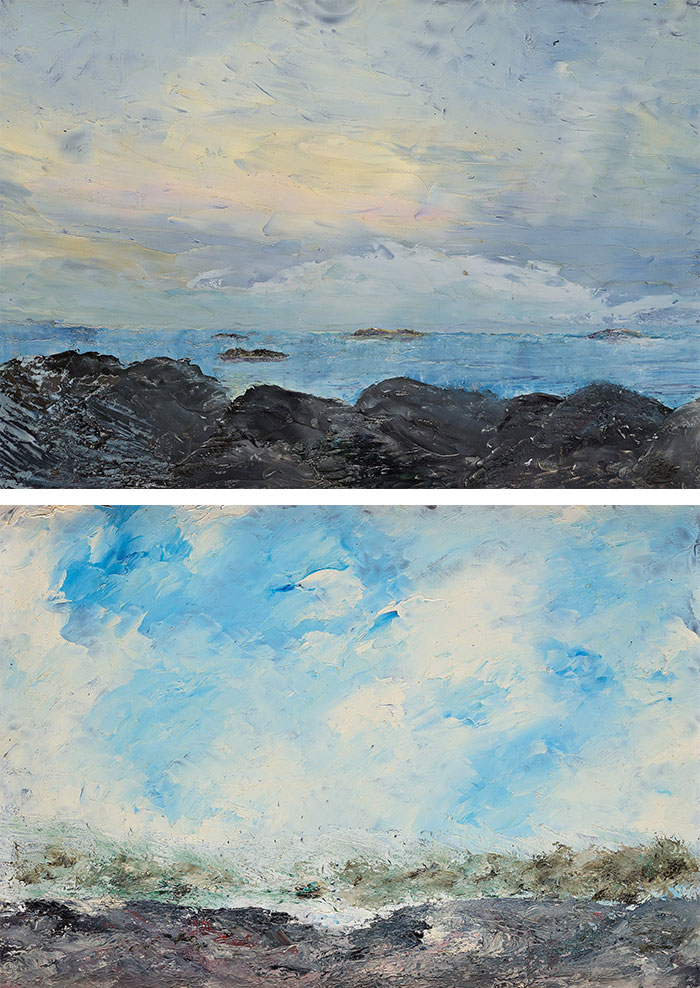

Bruno Liljefors, Sunset above the vast sea
Estimate: 1 500 000 – 2 000 000 SEK
The compositional structure for this sublime panorama differs from that of earlier landscapes by the artist. Its elements are frontally oriented and have been organized in more or less horizontal fields which can be read as parallel to the picture plane. With paintings such as Sunset above the vast sea from 1894, Bruno Liljefors participated in the renewal of Swedish landscape painting that took place during that time. These artists sought to define the identity of the Swedish landscape in highly personal, subjective pictures, and at the same time to create a new form of artistic expression. French Symbolism and Synthetism, in particular Gaugin, played an important role in this process. The new National Romantic art was characterized by its simplified form and its freer, more lyrical use of colour. The artists often chose to paint twilight moods where details emerged out of larger wholes. With its horizontal fields and its separation of colours, Sunset above the vast sea resembles a spectrum – as if Liljefors had wanted to demonstrate the significance of colour in the new landscape painting.
Carl Larsson, Hide–and–seek
Estimate: 4 000 000 – 6 000 000 SEK
Hide–and–seek is a veritable tour de force within Carl Larsson’s impressive oeuvre. The artist’s granddaughter Ulwa Neergaard has written the following about the boldly cropped composition with the diagonally emphasized perspective:
”The little girl hiding under the table while playing hide–and–seek is Carl Larsson’s daughter Lisbeth. The setting is the artist’s atelier at Lilla Hyttnäs in Sundborn. This adorable composition was painted in 1898 when the artist recently had endured a very heavy workload during the previous years. In 1897 Larsson had finally completed the prestigious frescoes in the foyer of the Nationalmuseum, as well as carried out the extensive decorations in the ceiling and the lunettes of the Royal Opera in Stockholm. On top of these gargantuan commissions he had also finished twenty-four watercolours depicting the Larsson family at home in Sundborn. These watercolours were intended for publication in the, nowadays iconic and legendary, book Ett hem (A Home) which came out, to great acclaim, in 1899. The twenty-four illustrations were technically very demanding to carry out since they were intended for reproduction/ printing. When painting Hide–and–seek Carl Larsson was, for the first time in a long time, unburdened by any patron’s wishes or indeed technical demands related to printing processes and could therefore let his imagination run wild. From a technical painterly point of view he was also liberatingly free in how he delivered the brushstrokes in a composition where he never had to worry too much about either motif or the perspective”
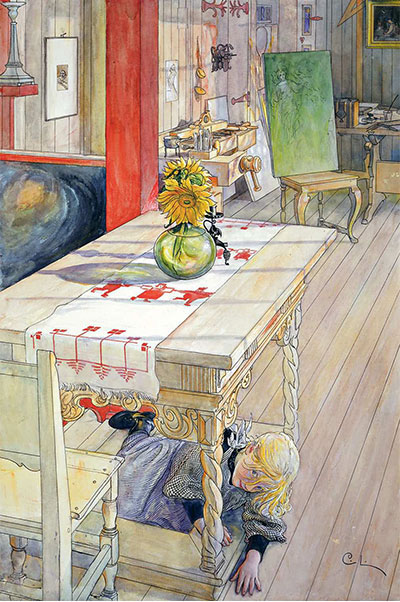

Christen Købke, Marina Grande, Capri, with a fishing boat in the foreground (detail)
Estimate: 800 000 – 1 000 000 SEK
Upon graduating from the Royal Danish Academy of Fine Arts in Copenhagen, many Danish artists of the Golden Age capped their education with long trips of further study. Many followed in the footsteps of academy professor C. W. Eckersberg who customarily set out for Rome or the coastline around Naples. Such journeys could extend for years. They traveled by sea on ships or across land in horse–drawn carriages. Some stretches were even traveled on foot. Only later in the century did the emergence of railway and steam engines make it possible to travel through Europe more expediently.
In 1838, Christen Købke was awarded a travel stipend from the Royal Danish Academy. He traveled together with the decorative painter Georg Hike (1807–1875), going to Italy via Dresden and Munich. Towards the end of the year they reached Rome where Købke met up with his brother– in–law the sculptor Frederik Krohn (1806–1883) and the company of other fellow artists.
The following summer Købke, along with Constantin Hansen (1804–1880), continued to Naples, Sorrento, Pompeii, and Capri. There outdoor subject matter abounded. Købke arrived on Capri in September 1839. He stayed for three months, producing several paintings and drawings of the island. Marina Grande, Capri, with a fishing boat in the foreground, in the current sale, is part of this body of work, and is closely related to View of Marina Grande, Capri (oil on paper, 29.9 x 39 cm, 1839, in the Hirschsprung Collection, Copenhagen, Accession #262, acquired by Hirschsprung in 1875).
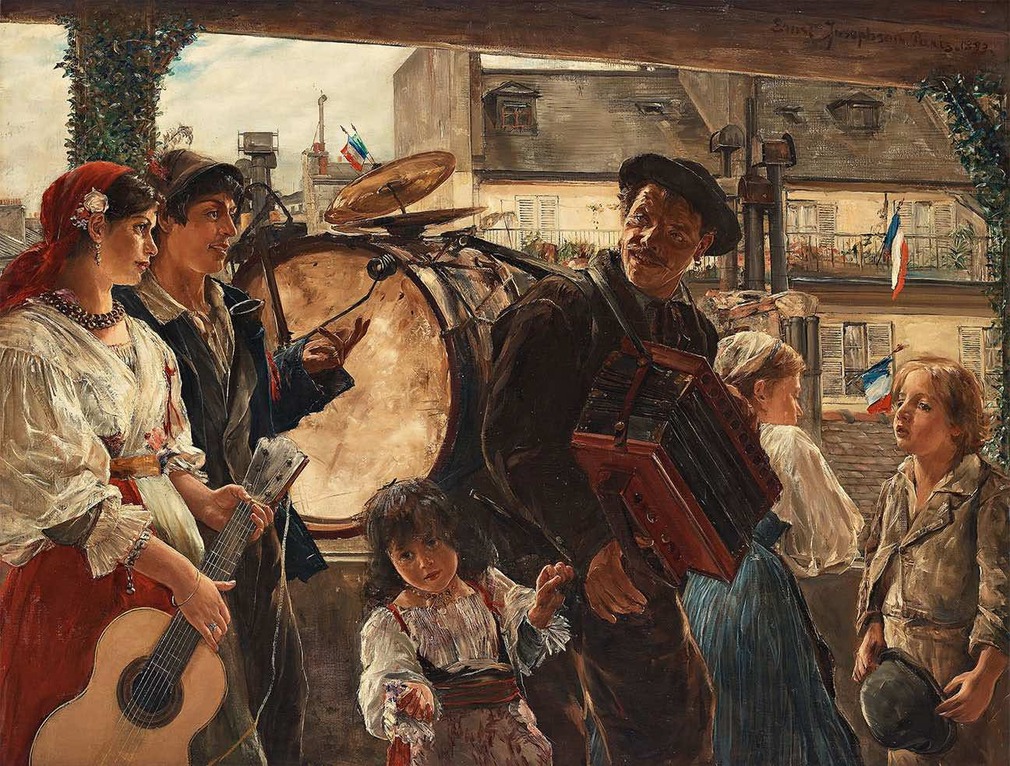
Ernst Josephson, July 14th
Estimate: 2 500 000 – 3 500 000 SEK
This vibrantly realistic depiction of the celebrations of July 14th, 1883, was painted in the artist’s new atelier, on the Rue Monsieur le Prince Montparnasse in Paris. Josephson had leased the new studio in 1882, upon returning from a longer stay in Spain in 1881. Erik Blomberg, an expert on Josephson, writes the following about July 14th in his 1956 book:
“Back in Paris, he pursues the rendering of every day genre scenes, albeit set in a new environment, still carried out in evident community with his earlier Spanish subjects. In the present painting he rounded up some Italian models, dressed up as street musicians on their way to celebrate the French National Day. He has set them up in front of his studio window with the apparent intention to make the spectator believe that he painted them in the open air. The window frame has been cleverly hidden with foliage. To the left is a blue–gray sky over the Parisian rooftops, with their typical chimney silhouettes. On the other side you can see upper floors and roof of a house where suspended tricolors give away the date in question By depicting the models as if marching past, Josephson sought to give the impression that the street view is also somehow temporary, fleeting nature, In fact, it was actually the view that met him every day in the studio, three flights up, overlooking the courtyard”.
Much to Josephson’s satisfaction July 14th was accepted by and exhibited in the “Paris–Salon, Exposition des Beax–Arts” of 1883. Karl Warburg writes about the exhibition: “Ernst Josephson comes forward at this exhibition with great strength and turns out to be one of the most distinguished painters of the Parisian school, with the vivid swiftness of painterly style which constitutes the ‘force of impression’. This is true, in particular, concerning a larger piece of his brush; ‘Italian musicians returning from the celebrations on July 14’ which deservedly has gained attention for its truth, life, and powerful rendering of the models”.







